Honey exports: The hunt for India’s sweet spot
India is the 7th largest producer and exporter of honey in the world. It exported 74,413.05 MT of natural honey in 2021-22, valued at US$ 163.77 million. TPCI’s research division analyses Indian honey’s export growth, and why UK emerges as a key potential market for its honey producers.
However, Indian honey faces lots of challenges in production, storage, infrastructure and quality that needs to be addressed before it can strengthen its foothold in the international market.

Image credit : Pixabay
Natural honey is a sweet, viscous food substance produced by bees from the nectar of flowers. It is a natural sweetener that has been used for thousands of years for its medicinal properties and as a food source. Natural honey is free from any additives, dyes, or flavours. It can be processed, to prevent crystallization or fermentation.
In terms of production and processing, “natural honey” and “artificial honey” differ from one another. Natural honey is made by bees from the nectar of flowers or honeydew. “Artificial honey” can refer to honey that has been processed or modified in some way, while “pure honey” refers to honey that has not been adulterated or combined with other substances.
The big-game players
China is the largest producer of honey. It has a vast agricultural landscape with diverse flora, providing abundant nectar sources for bees and a wide range of climatic zones, which allows the production of honey throughout the year. The Middle Kingdom also has a high domestic demand for honey.
This has led to large-scale commercialization of beekeeping in the country, with many small-scale beekeepers and large honey producers. The Chinese government has actively supported the development of the honey industry, providing funding and resources for research and development, as well as export promotion.
Chinese honey is produced at lower costs due to different production methods and government subsidies. This has resulted in Chinese honey flooding the global market, including India, and undercutting prices for Indian honey producers and impacting their market share and profits.
However, the quality and safety of Chinese honey has been a topic of concern in recent years. Reports of honey adulteration and contamination have raised questions about the integrity of the Chinese label. Nonetheless, China remains the largest producer of honey in the world, with a significant impact on the global market.
Another interesting honey producer to watch out for is New Zealand. It is one of the major exporters of honey and has a unique range of high-quality honey varieties, such as ‘manuka honey‘, which has gained a reputation for its medicinal properties. The beekeeping industry in New Zealand has been developed and modernized over the years, with a strong focus on sustainable and organic practices.
New Zealand has stringent quality standards and regulations for honey production and exports. This includes testing for purity, quality, and authenticity, which ensures that its honey meets the highest standards and is highly regarded in international markets.
New Zealand’s government has actively supported the development of the honey industry, providing funding and resources for research and development, as well as export promotion. Overall, the combination of New Zealand’s diverse flora, a long history of beekeeping and honey production, stringent quality standards, and government support have contributed to making New Zealand one of the world’s largest and most respected honey exporters.
Is India the rising star?
Honey and beekeeping have a long history in India. The raw materials for the beekeeping industry are mainly pollen and nectar that comes from flowering plants. Both the natural and cultivated vegetation in India constitute an immense potential for the development of beekeeping.
India is the 7th largest producer and exporter of honey in the world. It exported 74,413.05 MT of natural honey in 2021-22, valued at US$ 163.77 million and US$ 190.06 million in 2022-23 (Apr-Feb). The honey market in India was valued at Rs 23.3 billion in 2022 and is expected to grow at a CAGR of 8.4% to Rs 38.8 billion by 2028.
Northeast region and Maharashtra are key areas for Indian honey production. Rapeseed/Mustard Honey, Eucalyptus Honey, Lychee Honey, Sunflower Honey, Karanj/Pongamea Honey, Multi-flora Himalayan Honey, Acacia Honey, Wild Flora Honey, Multi and Mono floral Honey are some of the major varieties of Natural Honey are found in India.
Indian honey is also known for its medicinal properties and is often used in Ayurvedic medicine. It is believed to have antibacterial and anti-inflammatory properties, and some studies have suggested that it may help to boost the immune system and improve digestive health.
Global trade analysis
New Zealand accounted for 12% of global honey exports, valued at US$ 327.15 million in 2021 with a 7% CAGR between 2017 and 2021. It was followed by China (US$ 260.04 million, negative CAGR of 1%); Argentina (US$ 214.07 million, CAGR of 3%); Brazil (US$ 163.34 million, CAGR of 6%) and Germany (US$ 148.48 million, CAGR of 2%).
Top 5 sourcing countries
| Exporters | Value exported in 2021 (US$ Million) |
Annual growth in value between 2017-2021 (%) |
Annual growth in value between 2020-2021 (%) | Share in world exports (%) |
| World | 2719.70 | 3 | 17 | 100 |
| New Zealand | 327.15 | 7 | 0 | 12 |
| China | 260.04 | -1 | 2 | 9.6 |
| Argentina | 214.07 | 3 | 30 | 7.9 |
| Brazil | 163.34 | 6 | 66 | 6 |
| Germany | 148.48 | 2 | -1 | 5.5 |
Source: ITC Trade Map
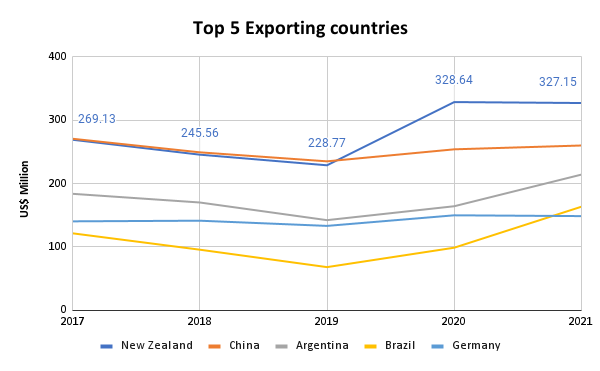
Source: ITC Trade Map
Top 5 importing countries
| Importers | Value imported in 2021 (US$ million) |
Annual growth in value between 2017-2021 (%) |
Annual growth in value between 2020-2021 (%) | Share in world imports (%) |
| World | 2,700.25 | 3 | 19 | 100 |
| United States of America | 668.84 | 2 | 52 | 24.8 |
| Germany | 314.76 | -1 | 13 | 11.7 |
| Japan | 169.85 | 5 | -2 | 6.3 |
| United Kingdom | 134.51 | 0 | 11 | 5 |
| France | 120.90 | -2 | -6 | 4.5 |
Source: ITC Trade Map
The US accounted for 24.8% of gl0bal honey imports, valued at US$ 668.84 million with a CAGR of 2% between 2017 and 2021. Germany came second (US$ 314.76 million, negative CAGR of 1%), followed by Japan (US$ 169.85 million, CAGR of 5%); UK (US$ 134.51 million CAGR of 0%) and France (US$ 120.9 million, negative CAGR of 2%).
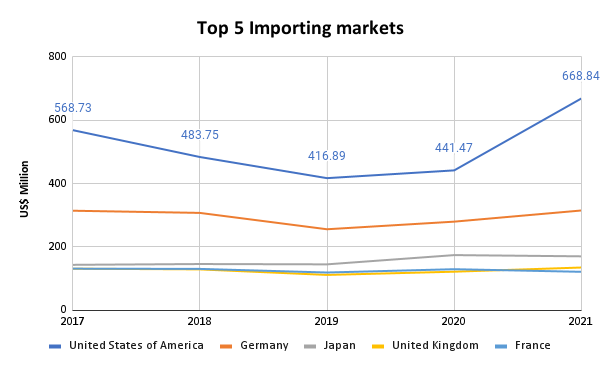
Top 5 Destinations for India
| Importers | Value exported in 2021 (US$ Million) |
Share in India’s exports (%) | Growth in exported value between 2017-2021 (%, p.a.) | Growth in exported value between 2020-2021 (%, p.a.) |
| World | 136.65 | 100 | 3 | 64 |
| United States of America | 106.78 | 78.1 | 1 | 94 |
| Saudi Arabia | 6.47 | 4.7 | 9 | 12 |
| United Arab Emirates | 6.37 | 4.7 | 12 | 24 |
| Nepal | 2.35 | 1.7 | 31 | 34 |
| Bangladesh | 1.72 | 1.3 | 10 | 5 |
Source: ITC Trade Map
India exported 78.1% share of its total honey exports to the US valued at US$ 106.78 million with a 1% CAGR between 2017 and 2021. It was followed by Saudi Arabia (US$ 6.47 million, CAGR of 4.7%), UAE (US$ 6.37 million, CAGR of 4.7%); Nepal (US$ 2.35 million, CAGR of 1.7%) and Bangladesh (US$ 1.72 million CAGR of 1.3%) respectively.
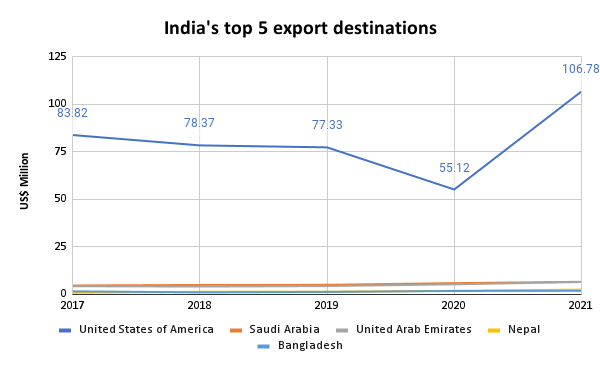
Source: ITC Trade Map
Top 5 source countries for honey exported to India
| Exporters | Value imported in 2021 (US$ million) |
Share in India’s imports (%) | Growth in imported value between 2017-2021 (%, p.a.) | Growth in imported value between 2020-2021 (%, p.a.) |
| World | 2.10 | 100 | -11 | 58 |
| Spain | 0.85 | 40.7 | -24 | 39 |
| Canada | 0.25 | 12.3 | 361 | |
| Bahrain | 0.15 | 7.5 | 237 | |
| New Zealand | 0.14 | 6.9 | 26 | 23 |
| United Arab Emirates | 0.14 | 6.8 | 39 | 153of |
Source: ITC Trade Map
In 2021, India majorly imported from Spain US$ 0.85 million with a negative CAGR of 24%, followed by Canada valued at US$ 0.25 million with a CAGR (N/A), Bahrain (US$ 0.15 million, CAGR of 237%), New Zealand (US$ 0.14 million, CAGR of 26%) and UAE (US$ 0.14 million, CAGR of 39%) respectively.
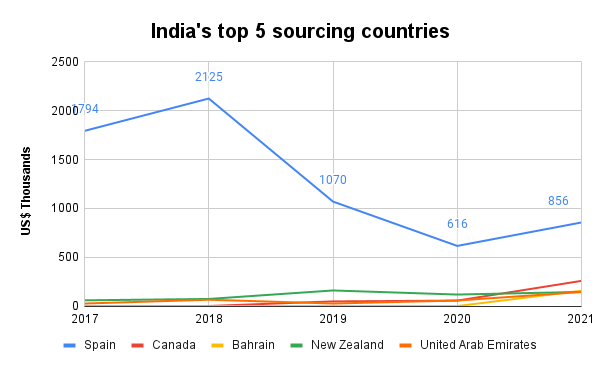
Source: ITC Trade Map
Target Market
United Kingdom is a major importer of natural honey with a recorded natural honey import of US$ 134.5 million in 2021. However, India’s exports of natural honey to the UK recorded a value of US$ 0.065 Million in 2021 with a negative CAGR of 3% between 2017 and 2021.
There could be multiple reasons why India is unable to export its honey in such a developed market, some of the potential trade barriers could be:
- The UK currently imposes tariffs on honey imports from countries outside of the EU.
- There may be specific standards and regulations related to labelling, packaging, and food safety that Indian honey producers may struggle to meet.
- India and the UK do not currently have a comprehensive trade agreement in place.
- There have been some concerns in the past about the quality of honey exported from India. This has led to increased scrutiny and testing of Indian honey by UK authorities, which can delay or even prevent exports.
The UK can be a great potential market to tap into if the hindrances are taken care of by both countries.
Government interventions for honey industry
The Indian honey industry is mainly dominated by small-scale beekeepers and honey collectors. The government has initiated various schemes and programs to promote honey production and export in the country. These include the National Beekeeping and Honey Mission, which aims to increase honey production and improve the livelihoods of beekeepers, and the Honey Mission in the Northeast region of India, which focuses on promoting honey production in the region. Some of the schemes include:
- National Beekeeping and Honey Mission (NBHM): The NBHM is a centrally sponsored scheme launched by the Indian government in 2017 to promote beekeeping and honey production in the country. The scheme aims to provide technical and financial assistance to beekeepers and honey producers, establish honey processing and testing facilities, and improve the marketing and export of Indian honey.
- Apiculture Mission: The Apiculture Mission is a state-level scheme launched by several state governments in India to support the development of the beekeeping and honey industry. The scheme provides assistance for setting up bee colonies, training in beekeeping and honey production, and access to marketing and export channels.
- Export Promotion Scheme: The Indian government has several export promotion schemes in place to support the growth of exports in various sectors, including honey. These schemes provide financial assistance to exporters, including reimbursement of certain taxes and duties, and support for marketing and promotional activities.
In recent years, the Indian honey industry has faced challenges due to the presence of adulterated honey in the market. The government has taken steps to address this issue by setting up laboratories to test honey for adulteration and by enforcing strict quality standards for honey exports.
Major challenges in Honey exports from India
Quality standards: Honey export requires meeting stringent quality standards set by international regulatory bodies, including the European Union and the United States Food and Drug Administration. The compliance of the honey to the standards is checked for authenticity and purity, absence of antibiotics, contaminants and other parameters.
The lack of standardized practices in beekeeping, harvesting, and processing of honey can hinder India’s ability to meet these quality standards.
Lack of infrastructure: The lack of appropriate storage facilities and transportation infrastructure can affect the quality and shelf life of honey, making it difficult for Indian producers to compete with other global players.
Limited production: As compared to countries like China and Turkey, India produces a limited amount of honey. This can lead to issues of demand and supply and make Indian honey less competitive in the global market.
Lack of brand recognition: Indian honey lacks brand recognition in the global market. This makes it difficult for Indian exporters to establish a foothold in the highly competitive global market and establish themselves as reliable suppliers of high-quality honey.
Price volatility: The price of honey in the international market is highly volatile, and fluctuations can make it difficult for Indian exporters to establish consistent pricing models.
Pesticide and pollution: The indiscriminate use of pesticides and pollution in agricultural areas affects nectar-bearing plants, leading to a decrease in honey production.
To overcome these challenges, India needs to focus on improving the quality of honey, increasing production capacity, investing in infrastructure, and developing a strong brand identity. Along with this, there should be a collective effort towards promoting sustainable and organic beekeeping practices, increasing awareness about the importance of honeybees, and supporting the livelihoods of small-scale beekeepers.








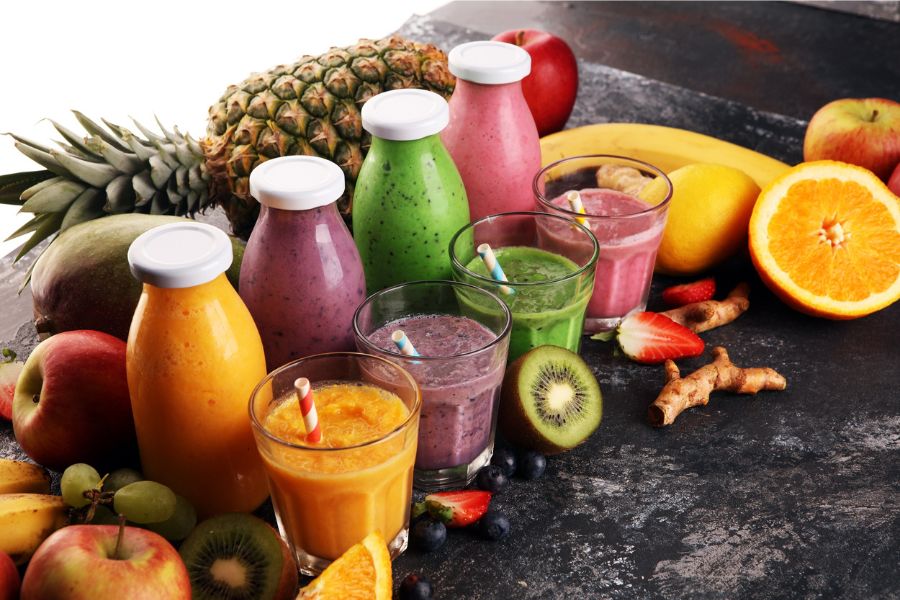




Amid India’s thriving honey export industry, local conveyor belt manufacturers play a crucial role in enhancing production and efficiency